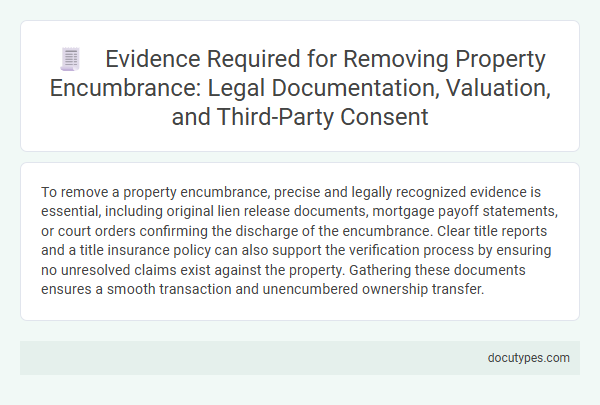To remove a property encumbrance, precise and legally recognized evidence is essential, including original lien release documents, mortgage payoff statements, or court orders confirming the discharge of the encumbrance. Clear title reports and a title insurance policy can also support the verification process by ensuring no unresolved claims exist against the property. Gathering these documents ensures a smooth transaction and unencumbered ownership transfer.
Introduction to Property Encumbrance
What type of evidence is needed for property encumbrance removal? Understanding property encumbrance is essential when dealing with any restrictions or claims on your real estate. Clear and convincing documentation is required to prove ownership or resolve disputes related to liens, mortgages, or easements.
Types of Property Encumbrances
| Type of Property Encumbrance | Description | Evidence Required for Removal |
|---|---|---|
| Mortgage Lien | A legal claim by a lender on your property as security for a loan. | Mortgage payoff statement, lender's release document, or satisfaction of mortgage recorded with the county. |
| Tax Lien | A claim imposed by the government due to unpaid property or income taxes. | Tax payment receipts, tax clearance certificate, or official lien release from the tax authority. |
| Mechanic's Lien | A claim filed by contractors or suppliers who have not been paid for work or materials supplied. | Proof of payment, lien release forms, or court orders dismissing the lien. |
| Easement | A right granted to another party to use a portion of your property for a specific purpose. | Recorded easement release, agreement termination documents, or court decree extinguishing the easement. |
| Judgment Lien | A lien recorded against your property following a court judgment for a debt owed. | Certified satisfaction of judgment, lien release certificate, or court order nullifying the lien. |
Legal Documentation Needed for Encumbrance Removal
Legal documentation needed for property encumbrance removal typically includes the original deed, court orders, and lien release forms. Proof of payment or satisfaction of the debt tied to the encumbrance is essential to clear the title. Additionally, a title report or certificate confirms that the property is free of encumbrances after removal.
Proof of Ownership and Title Verification
Proof of ownership is essential for property encumbrance removal and typically includes documents such as the property deed or a certificate of title. These documents establish the legal owner's rights and serve as primary evidence in clearing encumbrances.
Title verification involves a thorough examination of the property's title history, often by a title company or legal expert. Confirming a clear title ensures there are no unresolved liens, mortgages, or legal claims that could hinder encumbrance removal.
Mortgage Release and Loan Clearance Certificates
To remove a property encumbrance, key evidence includes a Mortgage Release document and Loan Clearance Certificates. A Mortgage Release proves that the lender has officially released the lien on the property. Loan Clearance Certificates confirm that all outstanding loan dues have been fully paid and settled.
Importance of Property Valuation Reports
Property valuation reports play a crucial role in the removal of encumbrances by providing an accurate assessment of the property's worth. These reports ensure all parties understand the current value, helping to resolve disputes and confirm fair transactions.
- Proof of Property Value - Valuation reports establish the market value, which is essential for negotiating the removal of liens or mortgages.
- Verification of Encumbrance Impact - These reports highlight how existing encumbrances affect the property's value and marketability.
- Authentication in Legal Proceedings - Courts and lenders require official valuation reports as credible evidence during encumbrance removal cases.
Obtaining No Objection Certificates (NOCs)
Property encumbrance removal requires specific legal evidence to confirm the clearance of claims or liabilities. One crucial document is the No Objection Certificate (NOC), which certifies that the concerned parties have no objections to the removal process.
Obtaining NOCs involves approaching relevant authorities such as banks, housing societies, or government departments associated with the property. These certificates are essential for ensuring clear title transfer and preventing future disputes related to encumbrances.
Consent Letters from Third Parties
Consent letters from third parties play a crucial role in the removal of property encumbrances. These letters provide documented permission that validates the release of any claims affecting your property.
- Third-Party Approval - Consent letters confirm that all involved parties agree to the removal of the encumbrance.
- Legal Validity - Properly drafted letters serve as legal evidence to support the discharge of liens or restrictions.
- Clear Documentation - These letters help prevent future disputes by clearly stating the conditions of consent.
Obtaining consent letters ensures a smoother and legally compliant process for encumbrance removal.
Role of Government and Regulatory Approvals
Government and regulatory approvals play a critical role in the removal of property encumbrances. Such approvals ensure that all legal and procedural requirements are met to clear any liens or restrictions.
To remove an encumbrance, you must obtain official documentation from relevant government agencies, proving that the encumbrance has been resolved or invalidated. This evidence typically includes release certificates, court orders, or clearance letters from regulatory bodies. Compliance with zoning laws, tax authorities, and environmental regulations may also be necessary to secure final approval.
What Type of Evidence Is Needed for Property Encumbrance Removal? Infographic

